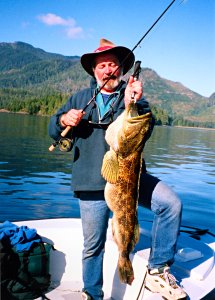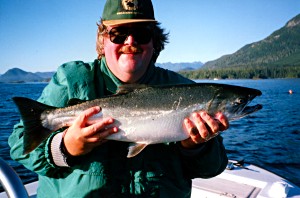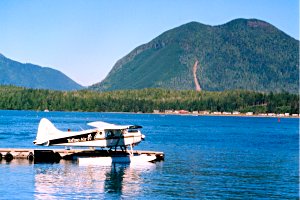|
|
|
List of BC Adventure Advertisers Site Info
Advertise With UsAwards About Us Contact Us  Kayak with Killer Whales Free Vacation Guides
BC Vacation GuidesCoastal Vacations Thompson Okanagan EcoTourism Fishing Vacations Guest Ranch Guide Romantic Getaways Wilderness Vacations Winter Vacations The Rockies Guide 
Coastal Spirits Expeditions Login |
Annual
Cycle of Runs Winter chinook inhabit local waters from October - March, reaching weights of 15 lbs. One to two pound blueback coho school in January to March. When weather permits, halibut fishing on the offshore banks proves successful 12 months of the year, with June - August being the prime period. Halibut move onto gradual dropoffs in the continental shelf 3 - 4 miles off Portland and Rafael Points. 20 - 40 lb chickens form the basis of the fishery, with fish to 200 lbs also taken. Summer fishing begins in April with early chinook bound for the Fraser and Columbia Rivers. Weights average 17 - 28 lbs. The bulk of the summer fish are chinook from Robertson Creek, Conuma hatchery, Nitinat River and Clayoquot Sound's Kennedy River. These fish average 25 lbs. When encountered, Sockeye peak in August.
Local chum may be seen spurting from the water in October.
Lures on an Annual Basis Hootchies: Utilize a 40" leader behind a Hotspot flasher for both squirts and hootchies. Patterns include Army Truck, tractor back (a chartreuse squirt) and the locally- named 'Tofino Dog Turd' 6" brown squid. Plugs: As with other Pacific Ocean shores, the 602 is favoured, however, in contrast to to other areas, 3 - 5" models predominate. Spoons: For summer chinook and coho, Coyote spoons in green and white and green and glow prove deadly. Other spoons include the Glendon Stewart, Gibbs Gator in mud pie and green and silver, as well as Krippled Ks in green and chrome and the frog pattern. Bucktails: Early in the season, pink bucktails take the most fish then give way to the Coronation, and Grey Ghost. The latter proves lethal on coho later in the summer. Drift Fishing: Magic Lures in green and white for both chinook and halibut. Other favoured drift lures include: Point Wilson Darts, Dungeness Stingers and Gibbs Minnows. Fly Fishing: Recently developed flies include: Catfaced Streamer, Weigh Wester, Pearl Mickey and Clouser Minnow.
Overall Strategy and Specific Fishing Areas In the Tofino area, the continental shelf drops off gradually from land to 600' and fish tend to swim along the shelf lines or inhabit the various rock piles 1 ½ - 10 miles out in the Pacific Ocean. It is not uncommon off Portland Point or Rafael Point to receive double headers of halibut and chinook at the same time. La Parouse is the local bank with the Southwest Corner a consistent spot. The surfline fisheries, also not for the faint of heart, occur right on rocky points where the swell rises and piles into the shore at Wilf Rock, Blunden Island, Bartlett Island and other spots. July to September is the prime chinook period with coho fishing extending from May into November in some years. The inside waters of Clayoquot Sound present safe year round fisheries for the seasick-challenged among us. Local rivers such as the Bedwell, Meglin, Moyeha, Clayoquot as well as Tranquil Creek all contribute chinook. Note that spot closures apply.
|
 Follow Us On Facebook Articles Coastal BC FisheriesSeafood Recipes (Pt1) Seafood Recipes (Pt2) Seafood Recipes (Pt3) Seafood Recipes (Pt4) Hot Spots
BamfieldCampbell River Gold River Hakai Pass Langara Island Port Alberni Port Hardy Port Renfrew Prince Rupert Rivers Inlet Shearwater Tofino Victoria Waterfront Salmon Online
Chinook SalmonChinook of Juan de Fuca Chum Salmon Coho Salmon Contacting the Fish Guide Your Way To Success Happy Halibut Hunting Happy Halibut Hunting (Pt2) Happy Halibut Hunting (Pt3) Harvesting the Herring Likes the Lakes Pink Salmon Sockeye Salmon Steelhead Bobber Tip The Butts of Bamfield Trolling Tip for Sidney Techniques
Boat Electrical PotentialCasting for Your Catch Drift Fishing (Pt1) Drift Fishing (Pt2) Mooching for Salmon Tough Knots for Big Fish Trolling for Salmon (Pt1) Trolling for Salmon (Pt2) Trolling for Salmon (Pt3) Winter Fishing the Capital Writers:
Peter Caverhill Brian Chan Fred & Ann Curtis Ian Forbes Geoff Hobson Gordon Honey Steve Kaye Fred's Custom Tackle Ron Newman D. C. Reid Philip Rowley Barry Thornton |
|||||||||||||||||
|
|||||||||||||||||||

 General
Description
General
Description  The
most significant development in recent summers is the coho fly
fishery developed by the
The
most significant development in recent summers is the coho fly
fishery developed by the 
 Coho
arrive early in Tofino, with good schools encountered as ravenous
5 pounders in June. These commonly feed so heavily they grow
a pound per week and by September reach the 12 - 15 lb range.
Northern numbers strengthen in August and continue building
through September. The Meglin River and Tofino hatchery support
good populations of coho.
Coho
arrive early in Tofino, with good schools encountered as ravenous
5 pounders in June. These commonly feed so heavily they grow
a pound per week and by September reach the 12 - 15 lb range.
Northern numbers strengthen in August and continue building
through September. The Meglin River and Tofino hatchery support
good populations of coho.  Tofino
has two types of fisheries: structure-related fishing for chinook
salmon and halibut; and, summer surface fishing for other salmon
species. In addition, three distinct fishing opportunities present
themselves: offshore bank fisheries; onshore surfline fisheries;
and, protected inside waters in Clayoquot sound. As with other
remote areas (although often unmentioned) lingcod and red snapper
abound.
Tofino
has two types of fisheries: structure-related fishing for chinook
salmon and halibut; and, summer surface fishing for other salmon
species. In addition, three distinct fishing opportunities present
themselves: offshore bank fisheries; onshore surfline fisheries;
and, protected inside waters in Clayoquot sound. As with other
remote areas (although often unmentioned) lingcod and red snapper
abound.